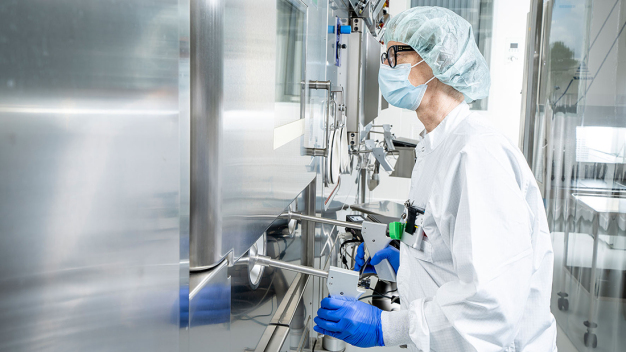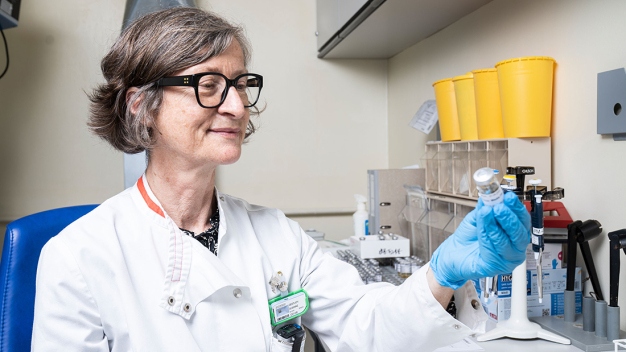- New building
Benjamin A. Senn
Swissmedic grants operating licence for new radiopharmaceutical production facility
The new pharmaceutical laboratory for the manufacture of radiopharmaceuticals at PSI is ready for production. With its three state-of-the-art production units, novel and innovative drugs can be brought rapidly into clinical use.
At PSI, with the help of a new facility, small batches of highly specific drugs will be produced in future. These will be delivered directly to hospitals for use in treating tumour patients.
For more than 20 years, in collaboration with ETH Zurich, PSI researchers have been developing new drugs for the diagnosis and treatment of tumours, so-called radiopharmaceuticals. These consist primarily of two components: a radioactive substance, the so-called radionuclide, and a biomolecule that functions as its carrier. The biomolecule is designed to dock at specific surface structures of cancer cells, thus, delivering the radionuclide to the tumour it targets. Depending on the type of radioactive decay of the radionuclide in question, the radiation emitted can either localise the tumour or attack the cancerous tissue.
The path from laboratory to clinic
It is a highly demanding and time-consuming task to search out suitable surface structures and combine the radionuclides with the appropriate biomolecules. In addition, processes must be developed that ensure clean and safe production of these substances under Good Manufacturing Practice (GMP) – which is defined by law – so that they can be used in the clinic. Susanne Geistlich, head of the Clinical Drug Supply Group at PSI, explains: "Before the drug is approved, the substances developed in the laboratory first have to prove themselves in clinical studies. The production of high-quality and reproducible drugs is essential to ensure the safety of patients and the reliability of the studies."
Radiopharmaceuticals are administered intravenously. To prevent contamination, for example with germs, the medication must be sterile. However, thermal sterilisation processes such as the standard ones used in drug production are time-consuming. Since radiopharmaceuticals only have a very short expiry date, determined by the so-called half-life of the radionuclide from a few minutes to a few days, they would mostly be unusable after such a procedure. To guarantee sterile products, the manufacturing process must be free of contamination and the entire laboratory must meet the highest hygiene regulations. Additionally, the filling systems are located in aseptic cells. Here, the injection doses are filled directly into product vials through sterile filters. The fine pores of the filters remove any germs from the product.
The short half-life of the radionuclides also rules out production for storage. As a result, the radiopharmaceuticals are only produced according to patient requirements and ordered for a specific time of injection.
Specialised production facility at a unique location
The high demands placed on rapid, high-quality drug production require not only know-how, but also the necessary infrastructure. The new pharmaceutical laboratory, which has now been granted an operating licence by the Swiss Agency for Therapeutic Products (Swissmedic), offers three state-of-the-art production units to meet the requirements of good manufacturing practice.
The three units to be operated are radionuclide-specific. This allows different biomolecules to be combined with one radionuclide per unit. To produce the radionuclides, the Centre for Radiopharmaceutical Sciences can use the particle accelerators at PSI’s large research facilities. While hospitals, such as the University Hospital Zurich, use compact, standardised medical cyclotrons for this purpose, the development of novel substances, as is the case at PSI, requires innovative systems that offer a wide range of accelerated particles and energies. This shows the potential of the unique laboratory infrastructure at PSI. "The immediate proximity to the large research facilities enables us to keep developing new drugs and to produce them directly onsite towards clinical studies," says Susanne Geistlich.
With PARK INNOVAARE, there is also an exciting opportunity for industry to settle in the immediate vicinity of the PSI. In future, the state-of-the-art campus will offer space for large established companies, small- to medium-size enterprises, and start-ups, which can use the infrastructure at PSI to bring innovative medicines to the clinics more efficiently. With its new production facility, PSI offers an attractive location to promote research on new radiopharmaceuticals, as well as to develop them and bring them to market.
Paul Scherrer Institut
5232 Villigen PSI
Switzerland










